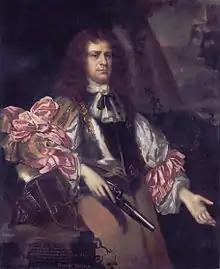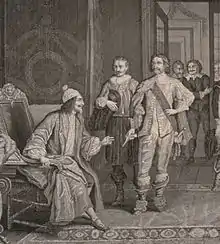George Joyce
Cornet George Joyce (born 1618) was a low-ranking officer in the Parliamentary New Model Army during the English Civil War.[1]

Cornet George Joyce (Jacob Huysmans)

An 18th Century illustration of Joyce's arrest of Charles I in 1647
Between 2 and 5 June 1647, while the New Model Army was assembling for rendezvous at the behest of the recently formed Army Council, Joyce seized King Charles I from Parliament's custody at Holdenby House and took him to Thomas Fairfax's headquarters on Triplo Heath (8 miles south of Cambridge),[2] a move that weakened Parliament's position and strengthened the Army's.[3][4]
On 17 June, 1650 Joyce was appointed governor of the Isle of Portland, in the August he was given a commission as lieutenant-colonel in a regiment raised by Colonel James Henne.[5]
Notes and references
- David Plant, George Joyce, Agitator, b.1618, British Civil Wars and Commonwealth website
- Triplo Heath is 8 miles south of Cambridge. (Jedidiah Morse, Richard Cary Morse (1823), New Universal Gazetteer: Or Geographical Dictionary ..., S. Converse. p. 772. This paragraph incorporates text from this source, a publication now in the public domain.
- Thomas Carlyle (editor 1861) . Oliver Cromwell's Letters and Speeches, Bernhard Tauchnitz. p. 275 On the evidence of the autobiography of the astrologer William Lilly, he was identified by Oliver Cromwell's Secretary, Robert Spavin, as the heavily disguised executioner of King Charles I.
- Woolrych, Austin (2004). Britain in Revolution: 1625-1660, Oxford University Press, ISBN 0-19-927268-9, ISBN 978-0-19-927268-6. p. 363
- "George Joyce". www.wikisource.org. Retrieved 26 January 2021.
This article is issued from Wikipedia. The text is licensed under Creative Commons - Attribution - Sharealike. Additional terms may apply for the media files.